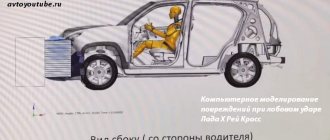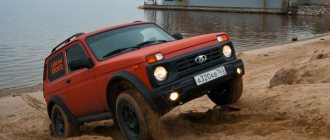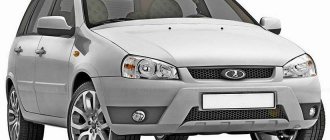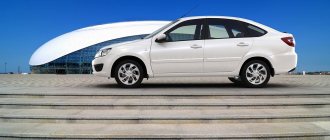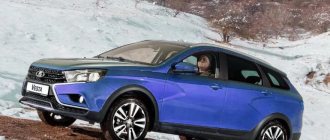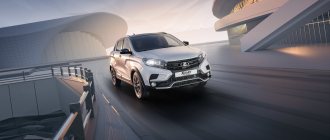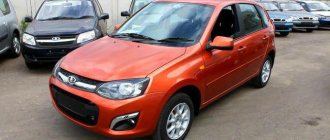Short overhangs, impressive ground clearance - what is not an SUV! At least externally, Xray Cross creates complete confidence that it was created not only for asphalt. Although there is still no all-wheel drive here. But there is a Lada Ride Select system, and we were able to test it on asphalt, off-road and in snow.
Maxim Fedorov
Lada Xray Cross Price: from 729,900 rub. On sale: from October 2022
The plastic body kit is secured with clips (holes are punched in the body panels) and taped with double-sided tape for reliability.
Who was driving all-wheel drive there? Installing it is not a problem, because the Xray is based on the same B0 platform as the Duster. But can you imagine how much the price will skyrocket? But Xray Cross is not cheap even with front-wheel drive. Although even for that kind of money, the new AvtoVAZ product is more profitable than its classmates. Competitors are either more expensive or worse equipped, and more often than not, both. Not counting the body kit made of unpainted plastic, the “base” already has 17-inch alloy wheels, roof rails, a double-barreled stainless steel muffler, LED running lights, an alarm system with central locking and rear disc brakes - by the way, they are here from “ Vesta." Even the new tires are not budget-friendly: the 215/50R17 all-season Continental, welded to AvtoVAZ’s special order, is wider and taller than that of the Vesta Cross. It also lies in the trunk as a full-size spare wheel, and on the original alloy wheel.
Contrasting brown inserts in the interior can be replaced with less intrusive gray ones.
The rear sofa cushion was moved back to the trunk by 2.5 cm - this modification, which made it possible to add legroom, was also received by the regular Xray.
High-profile tires added 5 mm to the hatchback's 195 mm ground clearance, and another 15 mm was gained due to new springs and shock absorbers. Moreover, they cannot be installed so easily on a regular Xray - you will have to change the front arms and CV joints. But we strongly do not recommend doing this, since it is unknown how such a car will drive. After all, the Xray Cross chassis was tuned not only for the new suspension, but also for the new electric power steering, installed instead of the electro-hydraulic one, which made it possible to reduce the gear ratio in the rack: from lock to lock, the steering wheel now makes less than three turns.
— When creating the Cross, 170 new components were introduced into the Lada Xray design, and the list of changes itself is even longer! — Oleg Grunenkov, director of the Lada Xray Cross project, who went with us to Kazakhstan for the first test drive of the new product, was clearly proud of the work done.
Indeed, the list of improvements turned out to be large, and not all ideas were realized. Thus, although sound insulation has been improved, it is only on the wheel arches and sills: sandblasting is now inaudible, but the noise of the engine and tires quietly penetrates the interior. Although AvtoVAZ heard our complaint. But something remained unrealized due to the design features of the model. For example, no matter how hard you try, you won’t be able to make the car more spacious without increasing the wheelbase: new front seats with a deep recess for the knees, as well as a rear sofa moved closer to the trunk and slightly lowered down, only partially solved the problem of cramped conditions in the back row. With a height of 186 cm, I fit behind myself, although without any reserve in my legs. But now there are heated seats and a USB charging port - not every higher-class model can find this.
The trunk has a double bottom. Underneath is a full-size spare wheel on a cast wheel.
The driver’s seat has also become more comfortable: a central armrest has finally appeared, and the steering wheel has been adjusted for reach (for the first time among models on the B0 chassis!) and heated. Other innovations include heated front seats with three degrees of “roasting”, the buttons of which have moved from the side of the seat to the center console, and now it is clear in which mode it operates. There is also a button to turn on the heated windshield and the main feature of the new product - the regulator of the Lada Ride Select system, thanks to which the Xray behaves completely differently both on paved roads and off-road.
Rails appeared on the roof (an additional stamp had to be introduced to install them) and an antenna “fin”.
The system has four operating modes. The Sport button changes the speed of response to pressing the gas pedal, and also “unfolds” the stabilization system a little, allowing you to slide when turning. It was not possible to test sliding, but the more responsive accelerator was a great help both when driving in the city and when overtaking on the highway: with it, the 1.8 engine seemed to get a second wind (there would be another 6th gear!). There is also a regulator with icons indicating the “snow” and “sand” modes, although the first can be used not only in snow, but also in mud, and the second - on gravel. Both programs allow you to simulate differential locking by braking the drive wheels and limit the intervention of the stabilization system. If necessary, stabilization can be completely turned off, but, as in the first two cases, when accelerating above 58 km/h, the ESC system will “wake up”. However, you can lose control on slippery surfaces even at lower speeds, so you need to use these modes carefully.
“Come on, come on, dear!” — I encouraged the Lada Xray Cross, whose wheels were polishing the snow-covered slope near the hotel in the foothills of the Tien Shan. But the wheels finally found a grip, and we crawled to the top, although until the last moment I didn’t believe that I could climb. Before this, we already had to retreat: with standard settings, the car could only climb up to the middle of the climb, but with the “snow” mode activated, everything went much more fun. The car was slipping, but it was moving! Of course, Lada Ride Select is not a replacement for all-wheel drive, but it is a fact that the system expands the vehicle’s capabilities and helps overcome difficult areas. In the dry riverbed riddled with potholes, along which we drove before the snowfall, the car’s passability was limited only by the protruding “lip” of the front bumper that clung to the ground. And yet, there will still be skeptics who will say that this is another “scam” by marketers. But AvtoVAZ does not force Lada Ride Select on anyone - you can take the Xray Cross without it.
It’s only a pity that the manufacturer does not provide the ability to choose an engine, and the 122-horsepower 1.8 has an increased appetite not only for gasoline (our average consumption was 12.4 liters - this is a lot even taking into account long periods of parking with the engine running), but also, judging by according to the owners' reviews, to the oil. And the list of transmissions at the start of sales will be limited: a version with an updated “robot” version 2.0 will appear later. Machine? Variable speed drive? No, we haven't heard. However, this will not scare our people: judging by the sales statistics of other Lada models, every second Xray buyer will choose the Cross version.
Ground clearance
Ground clearance has never been a problem even for the regular Xray. In the Cross version it has grown to an impressive 215 mm. The figure is decent for many all-wheel drive vehicles and is comparable to those of models such as the related Renault Duster or Kaptur. The increase in ground clearance was the result not only of changes in the suspension, but also of a different wheel size. Add to this the unpainted plastic around the perimeter, and the Lada XRAY Cross becomes a good choice for driving off asphalt.
Appearance
If we talk about off-road body kit, then XRAY Cross is a vivid example of how “armor” can benefit the image. The Cross really looks much more harmonious than the usual Xray: unpainted plastic unloaded the heavy image. The 17-inch wheels were also a plus. True, on a rough road, as our Karakum run showed, shoes should still have a higher profile. The roof rails also contribute to the attractive appearance, giving the car a utilitarian look.
Verdict
“Cross” is not just an attempt to make a semblance of an SUV out of a regular hatchback. For AvtoVAZ, this is also “working on mistakes”, in which they tried to take into account the feedback and wishes of the owners of Xray. True, most of these improvements will remain “exclusive” to the Cross version and will not appear on the regular Xray.
The editors recommend:
Why do piston rings stick and how to prevent it?
A traffic police officer searched my car: did he have the right to do so?
Russians may be left without foreign cars: Western automakers have stopped supplying cars to our country
A ship that was transporting cars to Russia was detained in France
Half of the car factories in Russia have closed
News Media2
Discussion Cancel
New options and features
Lada XRAY Cross boasts a number of new options. First of all, this concerns steering wheel heating - this is the first time such a useful option has appeared in our country on Ladas. And the rim itself can be covered with leather. On the Cross, the front seat heating buttons have finally moved from the end of the seats to the center console. The front seats have been redesigned and have more developed lateral support. The steering wheel now has reach adjustment. And the instrument cluster changed the color of the on-board computer display.
More about the 4x4 version
The start of sales of the Lada Xray 4×4 SUV has been postponed to the end of 2018* (see updated information below) not at the whim of AvtoVAZ management and not without good reason. This is due to the current state of affairs on the market.
According to marketers, the release of the Lada X-Ray 4x4 in 2016 is not the best option. They believe that this should be done a little later, when the Russian buyer is ready for it. Many experts argue that the Lada Xray Cross 4x4 will never go on sale at all, but it is clear that if necessary, domestic specialists are quite capable of converting the front-wheel drive model to 4wd.
The new technical characteristics of the Lada X Ray Cross will look something like this:
- standard 1.6-liter engine, with a choice between 106 and 114 horsepower;
- high-power engine with a volume of 1.8 liters, such a unit will produce 122 hp;
- transmission of two options - robot and mechanics;
- Lada X Ray Cross will be able to equip tires with a pressure sensor;
- the car will have a proprietary exchange rate stability system;
- built-in multimedia player equipped with a large 7-inch touch screen;
- the car will be equipped with a rear view camera;
- In addition to the 4wd drive, the Lada Xray Cross will receive new bumpers and a protective body kit. Ground clearance indicators will be increased.
The car will have the ability to overcome difficult sections of the route and off-road. Good cross-country ability will be ensured thanks to the 4 wd drive and directional stability system. This new option for the Russian crossover will allow you to get out of very difficult situations where most SUVs would not be able to get through. During testing, the car easily got out of holes and drove off roadsides and mud.
Lada Ride Select
Of course, the “off-road” version of Xray, like Vesta, does not have all-wheel drive. And it is unlikely to happen. But this modification still has some alternative. This is the Lada Ride Select system, which allows you to select one of five driving modes. It is also possible to disable the traction control system. There is also a sport mode, which sharpens the response to pressing the accelerator, and a “snow/mud and sand” mode, which not only changes the accelerator settings, but also allows a greater degree of slipping. We were able to fully test the latter mode in the Karakum sands. Of course, it will not replace all-wheel drive, but it will allow the car to move several tens of meters further than a regular XRAY.
Fists, grenades, bars: first test drive of Lada XRAY Cross, technical analysis and video
Let's sort out the prices right away so that there is no confusion. At first glance, it seems that the difference between the Lada XRAY Cross and Lada XRAY is significant, 100 thousand rubles, but this is not so. For a regular XRAY, the base engine is VAZ-21129 (1.6-liter with 106 hp), for XRAY Cross – already VAZ-21179 (1.8-liter with 122 hp), so if you compare similar modifications , then the difference will be around 50 thousand.
However, this is not a reason for joy: it makes no sense to take the basic Classic configuration, since they are not equipped with the Ride Select system, paired with which EDL works - an imitation of a cross-axle differential lock. It is this combination that gives the Togliatti new product a fair share of off-road properties. Actually, here it makes sense to remind you about the VAZ-21179 engine: it exclusively comes with enhanced clutch with a driven disk diameter of 215 mm versus 200 mm on other engines. And therefore, the likelihood of burning friction linings in the fields is significantly lower.
As for the box, this is again a unit from Renault (JR5-523), well known to XRAY owners, designed for an input torque of up to 210 Nm, despite the fact that the VAZ-21179 engine produces 177 Nm at maximum. The gear ratios for the XRAY Cross were not changed: according to the head of the XRAY project, Oleg Grunenkov, when pairs were selected for the regular XRAY with a 1.8 engine, the engineers already had in mind a version of the XRAY Cross with larger wheels.
Meanwhile, more than ever, in the case of the XRAY Cross, appearance is important to us, because it was the design solutions proposed by designer Steve Mattin that became the reason for extensive technical improvements. But in fact, what is remarkable about the XRAY Cross besides the aluminum roof rails, which seem to be visible from all angles and are required for all trim levels?
View this post on Instagram
Publication from Kolesa.ru (@kolesaru)
You, of course, noticed that compared to the regular XRAY, the new product expanded a little in width and became, as it were, squat, despite the fact that its height has increased. This is due to the fact that after the appearance of the plastic body kit, including wheel arch extensions, it was impossible not to increase the track, although initially they really did not plan to touch the chassis and not add extra costs. However, as the Togliatti residents themselves say, the car with the wideners and the old track looked terrible. At the same time, they didn’t take Steve’s option - he suggested setting the wheels too wide.
In fact, visually the car spread out to the sides partly due to the use of tires with a wider profile: the test XRAY Cross was shod with the all-season Continental ContiCross Contact set measuring 215/50 R 17. Let us recall that the 17-inch wheels on the regular XRAY are 205 mm wide , therefore, the tires were added to each side by 5 mm. Please note that tires for the XRAY Cross are not supplied by Pirelli, a long-time partner of AvtoVAZ. Allegedly, colleagues from Pirelli simply could not offer tires that would simultaneously withstand noise requirements and have the grip so necessary for the XRAY Cross. As for cooperation with Continental, according to Oleg Grunenkov, the new tires were actually developed from scratch, in particular, a mixture recipe was selected that best suited the characteristics of the suspension. These are exactly the wheels for XRAY Cross.
Along with the tires, the track also increased: in the front to 1503 mm (previously 1492 mm), in the rear – up to 1546 mm (previously 1532 mm), which was helped by a set of design measures: at the rear there were levers modified to take into account the appearance of disc brakes, and at the front - new ones drive shafts to the wheels. Let's look at the new Lada XRAY from below - everything is clearly visible, perhaps, except for the new anti-roll bars, the rod of which has become much longer.
As for the ground clearance, it nominally increased from 195 mm to 215, however, in reality, when the car is empty, we record no more than 195 mm: the lowest point was the transverse brace of the front subframe, which is clearly visible in the video.
View this post on Instagram
Publication from Kolesa.ru (@kolesaru)
But the new drive shafts are actually not completely new, that is, not completely new. Oleg Grunenkov said that part of the shaft on the gearbox side was borrowed from a regular XRAY, and part of the shaft on the wheel side was taken from the Lada Vesta Cross (like the steering knuckle). Only the middle part was redesigned, which provided an increase in length. The new L-shaped lever also appeared for a reason: the task was to bring the XRAY Cross closer in handling to the Vesta, and for me it turned out even better.
As for the wheels, as is clear from the history of the tires, they are also new, moreover, 17 inches is not the limit: the project director is determined to push through the 18 inches that he initially proposed! Closing the topic of wheels, we note that designer Steve Mattin received special praise from the engineering department for creating a design that was “beautiful and cheap to manufacture.”
The plastic body kit has a double fastening – mechanical (clips) and adhesive. This should ensure durability during operation outside of asphalt. As for protecting the engine from below, as was seen from the video, the engine is now located above the subframe and the front cross member will take the blows, while the safety tray itself is covered with a plastic boot. The subframe itself is standard, from the B0 platform, but modified to strengthen it.
Before we get into the driving impressions, let's take a look at the important changes to the interior.
View this post on Instagram
Publication from Kolesa.ru (@kolesaru)
As for the steering column, recall that the range of its angle adjustments is 5 degrees. But, of course, this is not all the interior upgrades. For example, instead of a one-stage heated seat, a three-stage one has appeared, and in addition, now passengers in the second row will also sit warm, although only their pillow is heated.
1 / 6
2 / 6
3 / 6
4 / 6
5 / 6
6 / 6
The rear seat cushions are now moved back so that the H-point (for the seat design dummy, this is the center of the hip joint) has moved back 25mm. That is, now the rear passengers began to sit more upright (the angle of the backrest decreased by 2 degrees - to 24 degrees), due to which legroom was increased.
The front seats are also original, they have pronounced lateral support sections, and the backrest can be folded in such a way that you get an almost flat platform for long cargo. Interestingly, they already have space for side airbags! This option may likely appear with the first dose of improvements.
The front seats for the XRAY Cross are supplied by Faurecia - its plant is not only located nearby, but is also completely synchronized with the Tolyatti assembly line. At Faurecia’s facilities, the electronics “see” what configuration of the car is currently being assembled, and the seats are ready just in time for them to be installed in the cabin.
The full-scale production of the new XRAY Cross was launched in Togliatti on the B0 line on October 11, however, we were given cars from pre-production batches for a test drive, which were six months old, in this sense we were asked not to pay attention to some flaws in the assembly of the interior.
The mentioned front seats look much better than they work. The lateral support sections, which are visually very prominent, barely hold up when turning, and the back itself did not provide comfortable support for the driver’s body: I interviewed a dozen colleagues of different sizes and did not find a single one who would praise the chair. The top layer of the backrest is too soft, the back simply collapses, especially in the lumbar region. At the same time, let me remind you that the car is designed for travel. In any case, those who are going on a long journey would do well to master the correct vertical position, since the height adjustment of the steering wheel now gives more freedom when choosing a comfortable position. By the way, the pillow for long trips is still a bit short.
Let's figure out if the Lada now has decent seats? But of course - there is! Yes, at least on the basic Vesta. Why not adapt? Oleg Grunenkov explains this by logistics: the capacity of Daywon, which won the contract for the supply of seats for Vesta, is based in Izhevsk, and it is expensive to transport them from Izhevsk to Tolyatti. Indeed, AvtoVAZ had already played enough with this logistics when the Granta liftback was assembled in Izhevsk - then the components went back and forth: first in the form of a separate storage unit, then as part of the car.
In the second row, oddly enough, the ride seemed more comfortable - and not only because there was more room for the knees and not only because you can safely put your feet under the front seat (as on the base XRAY, here the internal skids are on the tunnel). The simple design of the backrest seemed to me much more suitable for long-term stay in the car than that of the front backrests.
The Kazakh roads we traveled on at XRAY Cross were not very good, so they immediately paid attention to another important improvement. The reaction on the steering wheel, which previously occurred when the wheel hit an uneven surface, a hole, or an asphalt pothole, disappeared. I checked the sensations both on the dirt road and even on pebble roads, where we rushed at speeds of a hundred or more: the steering wheel became much more comfortable than before. The secret is simple: the electric hydraulic booster, where the slow pump created the pressure of the working fluid with a delay, was replaced with a well-tuned electric booster.
The only thing left to overcome is light impacts from transverse road joints. Quite a long stretch - we drove about two hundred kilometers on high-speed concrete, which at high speed turns into a “washboard” with incessant trembling on the steering wheel. To be fair, it should be noted that recoil from the joints appears precisely at high speeds. Actually, we didn’t deny ourselves anything, but we didn’t deny ourselves speed...
View this post on Instagram
Publication from Kolesa.ru (@kolesaru)
XRAY Cross inherited many soundproofing elements from the regular version. Let's say, even with the launch of version 1.8, soft noise-absorbing shields for the front arches were introduced - now they have been supplemented with pile base shields (in the area of the sills). In general, NVH packages are provided on the doors and sides, engine compartment and underbody, rear arches and trunk. And everywhere these measures worked and the tires are wonderful, but the engine compartment let us down: the 1.8-liter unit begins to stand out from the general background already starting from 3000 rpm, after another thousand you have to strain your voice, and at 5000 rpm it becomes completely acoustic discomfort. On the other hand, it is unlikely that our ordinary motorist, unlike the Kazakh, drives a Zhiguli at such speeds every day...
By the way: due to the increased weight - and only an extra 40 kg was added to the body - the car lost its dynamics. A regular XRAY accelerates to “hundreds” in 10.4 s, and a “hung” one in only 10.9 s. Fuel consumption has also increased: according to the passport, in the combined cycle the car now consumes 7.5 l/100 km instead of 7.2, but this does not at all fit with our measurements. Yes, on the highway the car easily gets out of eight liters, but in a city clogged with traffic lights it will be ten, and in Sport mode, which is discussed below, above 11 l/100 km. However, the new product has undeniable advantages and not only in handling and stability on asphalt, which, of course, should have improved following the increase in track. Now the stabilization system works a little later on the car, simply because the overall behavior has become more stable. This is especially noticeable when braking.
Lada XRAY Cross Claimed consumption per 100 km with manual transmission
| Consumption in the urban cycle, l | Highway consumption, l | Combined cycle consumption, l |
| 9,7 | 6,3 | 7,5 |
I had particular pleasure on the gravel road: the XRAY had definitely never demonstrated such confidence before. The car has excellent throttle control in gentle turns, does not jerk or lose course during emergency braking, and does not go astray during a sharp downgrade. Occasionally I had to catch the XRAY Cross in a slight skid, however, here too the car showed its full flexibility. I would also like to add a little more torque and sharpness to the engine response to gas, I would also like to increase the clarity of gear shifting, I would also like to make a smaller “hole” in the near-zero zone.
1 / 3
2 / 3
3 / 3
By the way: Oleg Grunenkov, when asked about the prospects for increasing the output of the 1.8-liter engine, said: “Of course, this engine has prospects, just don’t ask me about the timing of the launch of the new version.” It is clear that the block is cast iron, it can be loaded and loaded, as long as the next iteration does not make a mistake with oil consumption, as was the case with the first version of the VAZ-21179. Now they say it has been fixed.
However, all this is not at all important for the new XRAY Cross. The main thing is the puck. Yes, yes, in the cabin on the central panel, starting from the Comfort version (from 809,900 rubles), a Ride Select power unit operating mode washer is installed. Along with the basic modes, it allows you to select the Sport program, which improves engine response, and three programs with the stabilization system disabled: “Sand”, “Snow / Mud” and “ESC OFF”, in which the locking simulation works differently. Surprisingly, it is in sports mode that stabilization does not turn off! The VAZ people definitely couldn’t explain this, but they clarified that if we were missing something in Ride Select, they would be ready to correct the algorithm.
One of the routes in our section passed near a field with loose soil: with every step, my foot would slightly sink a centimeter or two. This did not bother the Lada at all - not without difficulty, with slipping, but I drove through this swell without resorting to switching with a puck and was just about to decide that it did not carry any tangible marketing load, when nature gave me a happy opportunity to confirm the opposite opinion. As if by order, snow began to fall in the evening and the next morning the ideal conditions for testing Ride Select were established. Let's say right away: this is not a panacea for all weather troubles and is not a guarantee of travel on the most difficult soils. First of all, working with Ride Select requires the driver to have confident skills in handling the gas pedal, and in all modes.
To begin with, I tried the system on a small, not yet rolled out asphalt slope, generously covered with snow. It turned out that the “Snow/Mud” mode was perfect for him: by carefully pedaling the gas, you can ensure that the electronics, by clamping the front brake discs, gently pull the car up the hill. However, with an increase in slope or, even worse, the appearance of areas rolled out to a slippery surface, this program loses its effectiveness. What helps? Oddly enough - the most common basic mode. It is in it (this is the impression) that the differential lock imitation system works most efficiently and most actively.
Then I climbed the hill using the Sport program, then turned off the ESC, and drove up, shamelessly slipping and turning the steering wheel, constantly trying to catch the clutch with the wheel that was starting to slip and slow down. In the end, I still drove up when the puck was on the “snowflake”, but, oddly enough, it will help the most savvy drivers. And how great it would be - without any of these tricks, to take and drive up a hill in one fell swoop on an all-wheel drive XRAY Cross...
Yeah, we were daydreaming. The project manager told us that at one time the Togliatti residents tried to find an affordable solution and considered all constructive analogues. For example, mounting the clutch on a semi-independent beam of the rear wheels, as on the Suzuki SX4, however, “the numbers didn’t add up” anyway, and the gradual weakening of the ruble forced us to abandon this idea altogether, because the clutch would definitely be imported.
In addition, in the next two years the new Lada 4×4 will go into production - it will definitely be all-wheel drive and, as VAZ people say behind the scenes, on the B0 platform, that is, on the same one as the XRAY. The question arises, why bother getting into your neighbor’s garden?
Lada XRAY Cross
Brief technical specifications
Dimensions (L x W x H), mm: 4,171 x 1,810 x 1,645 Engine: 1.8 l., 122 hp. Transmission: 5-speed manual / automatic, single clutch Maximum speed: 180 / 176 km/h Acceleration to 100 km/h: 10.9 / 12.7 sec Drive: front-wheel drive
In short, Oleg Grunenkov summed up all our conversations according to the 4x4 version as follows: “From a business point of view, from an investment point of view, everything must be reliable, so we need to make rational decisions in order to remain stable in the market.” Therefore, the discussion about all-wheel drive on the XRAY could be stopped, if not for our hope in the undying militarism of Steve Mattin. But how he takes it, how he draws something, how he sketches out a sketch, how he adds a couple of necessary touches, you see, and if the engineers don’t get away with it, they will add a coupling...
Survey
Would you take XRAY Cross?
Your voice
Total votes:
Chassis
In addition to many updates in the cabin and the appearance of the Lada Ride Select system, Xray Cross also underwent modernization of the chassis. The front suspension arms are similar to West's. It also comes with electric power steering. And, of course, disc brakes on all wheels. All this inevitably affected driving performance. The XRAY Cross rides on a winding road much nicer and clearer than the regular XRAY. Reactions to the steering wheel have become more accurate, and early drift of the front axle when overspeeding has disappeared. And an endless number of vibrations and shocks on uneven roads are no longer transmitted to the steering wheel.
AT of a perfectionist. How the XRAY Cross AT rides and slips - the first Lada with a CVT
A long search for the optimal “automatic” at AVTOVAZ ended with the appearance of the XRAY Cross AT car - with a CVT.
In the famous diagram “The Repair Paradox in Russia” the options “fast”, “high quality” and “inexpensive” intersect like Euler circles, giving the only answer: not in Russia. The situation with us is approximately the same with advertising, service, mail delivery and automatic transmission for Lada. A cheap car with a traditional automatic transmission exists - this is the Granta AT and its four-speed Jatco gearbox for 596 thousand rubles. The most affordable car with “hydromechanics” in our entire car market! True, its gas mileage is such that you will quickly lose almost all your savings. The cheap option with little appetite is no longer an “automatic”, but a single-clutch “robot” AMT, which is similar to “automatic” only in that it does without a third pedal. In theory, there is also an economical “real automatic” - its role was to be played by the Russian-developed seven-speed KATE FT703 transmission, which AVTOVAZ tried on the Kalina back in 2010. But the forecast for its appearance on Lada is simple: never. And the price of a Vesta with an “aurus automatic” is scary to even imagine.
Thus, a cheap and economical traditional “automatic” on a Lada can exist only in one case: not on a Lada.
Anyone has automatic machines. Renault will offer you a four-speed DP0 gearbox for only 30 thousand rubles. For the Ravon Nexia R3 sedan, “hydromechanics” costs 37 thousand, for Kia Picanto, Rio and Solaris - 40 thousand, and this is a modern six-speed transmission. For Polo the same will cost 45 thousand, and for Fiesta - 60. On Grant and Kalina, the surcharge for an outdated “automatic” for some reason is 55,300 rubles. And the price would be fine, but for other Lada models such a transmission is not available at any price.
However, from mid-August AVTOVAZ began producing XRAY Cross hatchbacks with a CVT. You look at them and think: isn’t this what an ordinary Russian needs? Almost a crossover with almost an automatic transmission. The ground clearance is large, the suspension is impenetrable. Yes, a single drive, but the price is below a million. X-Paradise for the Russian motorist. Called AT.
XRAY Cross with the AT prefix - this is the name of the stepless XRAY. So as not to scare the population with the tricky abbreviation CVT. And, apparently, to justify the price, because the variator on the XRAY costs almost the same as a “real automatic” on the Grant - 50 thousand rubles.
AVTOVAZ’s search for the right approach to two-pedal operation lasted almost a decade. The Jatco “automatic” successfully fitted the Granta and Kalina, but did not fit into the Priora and, moreover, became much more expensive after 2014, so AVTOVAZ focused on the budget “robot” with which Vesta and XRAY were launched. In 2018, he was taught to change gears faster and crawl with the brake pedal released, but by this time the Alliance decided that the new models of the B+ and C+ segments should only have CVTs, so the concept of the Lada also changed.
XRAY Cross AT became the first “continuously variable” AVTOVAZ car, but this status did not bring any external differences. Only in the cabin a selector lever with a traditional set of modes appeared - the same as on the Sandero Stepway City hatchback. The Jatco JF015E variator itself is familiar to us not only from Sandero, but also from Renault Kaptur 1.6 and Renault Arkana 1.6, as well as from some Nissans. All-wheel drive is not compatible with this transmission.
But along with the CVT, the XRAY Cross also acquired a new engine. More precisely, the new old one - after all, the 113-horsepower Nissan HR16 engine (aka Renault H4M) was already installed on the XRAY at the very beginning of production, but then some of its parts had to be imported from Japan by plane, so in 2016 the HR16 was replaced with VAZ engines for cost reasons . Now the Japanese aspirated engine is returning. Because since 2016 it has been almost completely localized, including the casting of the cylinder block and cylinder head in Togliatti. It would be more expensive to adapt the variator to any of the VAZ engines. In other words, XRAY Cross will now exist in two versions - with a Russian heart (1.8 MT, 122 hp) or with a completely Alliance heart (1.6 AT, 113 hp).
The HR16 engine has an aluminum cylinder block, an intake variable timing mechanism and a timing chain drive. The cooling system of the engine and variator is common
But this is only Cross, and the regular XRAY will retain exclusively domestic engines, “mechanics” and “robot” AMT. Already confused? Take a deep breath, don’t blink, and follow the flight of engineering and marketing thought.
So, Renault puts the ancient DP0 automatic transmission on Logans and Sanderos paired only with the French K4M engine (102 hp), which is old and does not justify investments in localization, so such a power unit is contraindicated for new Ladams. And CVTs are currently only compatible with the more modern H4M engine. True, there is a nuance: the massive variator crankcase hangs under the bottom 25 mm lower than the crankcase of a manual or automatic transmission. It is for this reason that Renault installs continuously variable transmissions only on elevated versions of the Sandero Stepway, Logan Stepway, as well as on crossovers. And that’s why so far only the XRAY Cross is equipped with a variator, which uses a subframe from Duster, which allows it to maintain the nominal 215 mm of ground clearance. In a regular Xray, like Logan, the variator housing will hang helplessly under its belly. That is, it won’t, because such cars won’t appear.
But Vesta is free from such problems, so it will receive a CVT in all versions, regardless of ground clearance. Simply put, XRAY with a CVT is only Cross, Vesta is any, and the rest of the models retain the existing transmissions.
Phew, looks like we've sorted it out. Let's try to get going.
The start is very easy, like on an automatic machine - the XRAY starts rolling right away, and this is convenient in traffic jams. During smooth acceleration, the variator does not howl or slow down, but it is not in a hurry either. And if you don’t pay attention to the overly heavy steering wheel, then calm movement around the city seems to be the true calling of the stepless Ixray.
However, in heavy traffic, speeding up the transmission will be difficult. If you need to energetically jump out of the yard or jump into the next row, you will have to wave the accelerator pedal like a conductor: the variator simply will not notice sluggish throttling. It would have really benefited from the Sport mode with sharper reactions to the gas, but where did the Ride Select puck with the “sports” button go, which is installed on the “mechanical” XRAY Cross?
She won't be there. After all, the original Alliance power unit does not provide such modes, and calibrating new algorithms specifically for the Lada requires an additional budget and time frame. Therefore, if you want to go faster, pull the lever towards you and change virtual gears manually. By the way, there are six of them here - and the motor on each spins up to almost 6000 rpm. This is more fun, but the XRAY Cross is still not suitable for fast driving.
There was barely enough power with the 1.8 engine, and the new power unit is both weaker than the base one and heavier - a total of 13 kg (the Japanese aluminum engine is lighter than the VAZ cast iron engine, but the variator itself weighs 71 kg instead of 34 kg for the “mechanics”). The continuously variable XRAY Cross can start with two pedals and accelerates “to the floor” like “stepped” cars - in three shifts to “hundreds”, but according to the passport this process takes 12.3 seconds, but in reality it stretches out to about thirteen. That is, the XRAY Cross AT is slower than the eight-valve Granta! Although faster than the Kaptur 1.6 AT or Granta with automatic transmission.
But what’s more annoying is that accelerations after 100 km/h are loud and strained. The CVT can respond to kickdowns and sharply reduce the gear ratio when overtaking, but if the accelerator is not pressed all the way, then there is a chance to witness a rare spectacle when the driver presses on the gas, the car accelerates, and the speed drops.
In manual mode, fourth gear is most suitable for overtaking on the highway, and in fifth you can push, you don’t have to push - the speed almost doesn’t depend on it.
There is another reason to drive slower - the steering wheel is too sharp and too tight at zero. The neutral position of the steering wheel is not indicated by any force, but the slightest deviation takes you away from the trajectory. After 120 km/h, the XRAY becomes nervous and does not hold its course well. Maybe it’s good that the top speed with the CVT dropped from 180 to 162 km/h.
But cruising at 80-100 km/h is the ideal pace for Xray. It is in this mode that the CVT does what it was designed for - it frees the driver from unnecessary work and gives the driver a chance to relax behind the wheel.
Moreover, it saves gasoline: fuel consumption, compared to the 1.8 MT version, has decreased from 7.5 to 7.1 liters per hundred. But in reality, it seems that the XRAY Cross AT is completely stuck: I filled the tank with a full tank, drove 215 km, but the fuel gauge did not move a single division. True, this is explained by the configuration of the tank neck: after cutting off the filling nozzle, another 20 liters fit in the XRAY, and the true tank capacity is not 50, but 61 liters. Well, the actual consumption during the test drive was 9.0 liters per 100 km. And by the way, this could be “ninety-second.” Nice.
The good news is that the XRAY Cross AT remained a Cross almost to the same extent as the manual version. They have no differences in suspension and ground clearance; for the sake of the extra 13 kg, AVTOVAZ did not even reconfigure the shock absorbers. Therefore, on broken asphalt and on primers, the XRAY Cross with a CVT feels excellent, not noticing potholes. But on good asphalt, on the contrary, it seems harsh due to the increased attention to the microprofile.
The steering gear, rear disc brakes and original front wheel knuckles also remain unchanged. The only difference, besides the engine and transmission, is the intermediate support of the right drive shaft, with which the axle shafts for the first time on front-wheel drive Ladas acquired the same length. It's a pity that such a support will not appear on the MT version.
The intermediate support of the right drive made it possible to equalize the length of the axle shafts and neutralize the effect of power steering during acceleration
I was preparing for the fact that the CVT XRAY would turn out to be an even more conditional “rogue” than the original XRAY Cross, because together with the Ride Select washer, it also lacks special “off-road” ESP operating modes, which change the permissible degree of slipping when driving on sand and snow. By the way, I think that these modes were one of the reasons why Ride Select was not paired with a CVT, because VAZ engineers know that the JF015E transmission does not like slipping.
Driving with wheel slippage, impacts when traction is quickly regained, and climbing curbs when the driver opens the gas and the wheels do not immediately begin to rotate. These are the same modes in which the belt in the Japanese variator could slip and scuff marks appeared on the pulleys. In such cases, ESP is designed to protect the belt and choke the engine along with slipping. At least on Renault and Nissan cars.
To test the XRAY Cross AT, I found a boat ramp to the Baltic Sea in the city of Solnechny, turned off ESP (it is completely deactivated at speeds up to 50 km/h), relieved the pressure in the wheels, turned on the video cameras, drove onto the sand and pressed the gas to the floor. Half-flat ContiCrossContact M+S tires rowed like tank tracks, the engine roared, the variator stank, but continued to work. During the forty minutes of filming, the XRAY Cross AT never dug into the sand or went into emergency transmission mode. I'm sure the real owners will be much more merciful.
An additional two-stage planetary gearbox allows the variator to avoid running the belt at small radii, when the risk of slippage is greatest. In addition, the gearbox reduces the load when engaging reverse gear. The main pair of the variator with a ratio of 3.882 is the longest among all versions of the Lada XRAY (another explanation for the decreased appetite). This diagram does not show the torque converter, which makes the variator similar to traditional automatic transmissions. By the way, AVTOVAZ recommends warming up the transmission for 30 seconds after starting, prohibits starting the XRAY Cross AT “from the pusher”, but allows towing a trailer weighing up to 650 kg without brakes and up to 800 kg with brakes
Although the service life of the variator still leaves questions, because if Renault and Nissan advise changing its working fluid every 60-80 thousand kilometers, then the XRAY Cross AT does not require this. Caring about reliability, VAZ calibrators made the process of changing gear ratios a little smoother (apparently, this explains the calm nature of the variator), and now AVTOVAZ claims that the fluid is designed “for the entire service life of the car.” True, according to VAZ standards, it is eight years or 120 thousand kilometers, so it’s better to change it anyway.
By the way, the warranty for XRAY Cross AT is the same as for other models - three years or 100 thousand kilometers. But the price is one of the highest. The basic XRAY Cross AT in the Comfort Optima version (with air conditioning) costs 847 thousand, like the most expensive regular XRAY with full stuffing. And for the top-end XRAY Cross AT Luxe Prestige you need to pay 972 thousand - excluding metallic paint. Only Vesta Sport is more expensive.
But if you compare it with direct competitors in the compact crossover segment, it turns out that the CVT XRAY for 847 thousand is the most affordable two-pedal car in this genre. Only the Sandero Stepway with an automatic transmission is cheaper (810 thousand), while the Kia Rio X-Line is 82 thousand more expensive, the Renault Kaptur 1.6 2WD is 148 thousand more expensive, and the Creta 1.6 2WD is 214 thousand more expensive. And from this point of view, the VAZ AT is almost a paradise for the average Russian motorist.
| Passport details | ||
| Cars | Lada XRAY Cross | Lada XRAY Cross AT |
| Body type | five-door hatchback | |
| Number of places | 5 | 5 |
| Dimensions, mm | ||
| length | 4171 | 4171 |
| width | 1810 | 1810 |
| height | 1645 | 1645 |
| wheelbase | 2592 | 2592 |
| front/rear track | 1503/1546 | 1503/1546 |
| Trunk volume, l | 361—1207* | 361—1207* |
| Curb weight, kg | 1295 | 1308 |
| Total weight, kg | 1650 | 1650 |
| Engine | petrol, with combined injection | |
| Location | front, transverse | |
| Number and arrangement of cylinders | 4, in a row | 4, in a row |
| Working volume, cm³ | 1774 | 1598 |
| Cylinder diameter/piston stroke, mm | 82,0/84,0 | 78,0/83,6 |
| Compression ratio | 10,3:1 | 10,7:1 |
| Number of valves | 16 | 16 |
| Max. power, hp/kW/rpm | 122/90/6050 | 113/83/5500 |
| Max. torque, Nm/rpm | 170/3700 | 152/4000 |
| Transmission | manual, 5-speed | V-belt variator |
| Drive unit | front | front |
| Front suspension | independent, spring, McPherson | |
| Rear suspension | semi-independent, spring | |
| Front brakes | disc, ventilated | |
| Rear brakes | disk | disk |
| Tire size | 215/50 R17 | 215/50 R17 |
| Maximum speed, km/h | 180 | 162 |
| Acceleration time 0—100 km/h, s | 10,9 | 12,3 |
| Fuel consumption, l/100 km | ||
| urban cycle | 9,7 | 9,1 |
| suburban cycle | 6,3 | 5,9 |
| mixed cycle | 7,5 | 7,1 |
| Fuel tank capacity, l | 50 | 50 |
| Fuel | gasoline AI-92—95 | |
| * With rear seats folded down | ||
The first disadvantage is the price
At the price in the maximum configuration, XRAY Cross has reached a new psychological mark of 900 thousand rubles. And although prices are now high for all cars, very few are willing to pay almost a million rubles for a Lada. On the other hand, not so long ago such a psychological mark was half a million rubles, then 700 thousand rubles... Nevertheless, even for this money Ladas are selling well.
avtoexperts.ru
We have already devoted an article to the “regular” Lada Xray. The material turned out to be not very complimentary, we strongly criticized the car, but what can you do if the car turned out to be not very successful. Sales statistics confirm the conclusions; other AvtoVAZ models sell better. It seemed that Xray would suffer for another two or three years on the assembly line, and then quietly fade away. However, at the end of 2022, Tolyatti engineers managed to surprise by releasing the Lada Xray Cross - read a redesigned and corrected version of the regular Xray. The improvements turned out to be so global that an almost new model was released.
Lada XRay Cross
Firstly, the body received a plastic body kit. This is a feature of all Cross series cars. Some people think it’s prettier, others think it’s more practical, because the plastic doesn’t need to be painted if something happens.
Secondly, the suspension was redesigned, instead of A-shaped arms, which became the hallmark of the B0 platform, L-shaped ones were introduced, much like on Vesta. The engineers borrowed the front knuckles and brake discs from Vesta. Thanks to the modernization of the anti-roll bar, it was possible to increase the travel and energy intensity of the suspension, although they were already considerable.
Suspension Lada XRAY Cross
Thirdly, disc brakes appeared on the rear axle; the mechanisms were again taken from Vesta, but this is an epochal fact for the B0 platform. The changes to the suspension were completed by wheels measuring 215/50 R17. They decided to install the expensive Continental from the factory.
Disc brakes
But that is not all. Fourthly, instead of the traditional power steering, an electric booster has appeared, and the rack now used is not the same as on the “original” car. This made it possible to soften the impacts on the steering wheel on a bad road, which are well known to all owners of cars on the B0 platform, and slightly improve handling. Thanks to the new design of the steering column, it was possible to realize what many owners of cars on the Logan platform dream of - adjustable steering wheel reach. Yes, the range is small, but it is still there.
Fifthly, the interior was slightly redone, functions for heating the rear sofa and steering wheel appeared, the button for heating the front seats finally moved from the blind spot near the door to the dashboard.
Center console
A cool feature has appeared - folding the front passenger seat into a flat area, this allows you to transport long items even in a very compact car. The front seats, by the way, have also been modified, they have become more comfortable, and the rear sofa is installed differently, which allows us to gain some legroom for passengers.
Folding the front seat
And like the icing on the cake. Sixthly, the Lada Ride Select system has appeared, which allows you to control ESP operating modes. We have never seen anything like this on Lada cars. The system allows you to configure the differential lock simulation depending on the road situation (sand, snow), as well as enable the sport mode. However, we will talk about Lada Ride Select later.
Interior
Of course, Cross turned out to be more expensive than regular Xray. In comparable configurations, the difference reached 60-80 thousand rubles, and the maximum Cross generally exceeded the psychological mark of 900 thousand rubles. However, it is in this case that the additional payment seems quite appropriate to us. It’s hard to blame us for advertising (read our other materials about cars, we usually always criticize), but Cross is really better than the regular Xray and, in our opinion, it’s worth the extra payment. However, one should not assume that this is an ideal car. A number of its shortcomings migrated from the regular Xray, and some more appeared after modernization.
No budget packages
Xray Cross, even in the minimum configuration, costs 755 thousand rubles, and that’s a lot. Obviously, it would be possible to make a more affordable version of the car by abandoning some of the options and replacing the 1.8 engine with a 1.6. For some reason, AvtoVAZ doesn’t give buyers a choice – 1.8 and that’s it. Although 1.6 would allow saving both on purchase and maintenance.
We were about to accuse the Xray Cross of having no alternative, but two days before writing the article, news came that AvtoVAZ had started assembling the Xray Cross (and only that one for now!) with the Nissan HR16 engine (it was installed on the first Xrays, but then it was considered too expensive) and a variator. The long-awaited appearance of a continuously variable transmission should make the car more attractive in the eyes of buyers, although such versions will appear only at the end of the year (and the price, we assume, could approach a million rubles), for now there is no choice - only 1.8 and “mechanics” AvtoVAZ doesn’t even install its single-disc “robot” on Xray Cross.
CVT JF015E
Cramped interior
This is the legacy of the B0 platform. Although VAZ engineers went to great lengths to install the rear seat, the entire gain was 25 millimeters, which is absolutely nothing. Xray was cramped for the inhabitants of the second row, and remains so . The trunk volume has also not increased, although its organization is quite interesting. In terms of cargo transportation, the only cool thing was the folding of the front seat; it’s convenient to transport long and bulky things in the car, but something large is no longer possible. As well as the tall passengers in the back.
The luggage compartment volume is 361 liters.
Tricks with ground clearance
Any AvtoVAZ car with the Cross prefix differs from the original in two things - a plastic body kit and increased ground clearance. Even the original Xray proudly looks at the world from a height of 195 millimeters, which is considerable for a passenger car. And the Cross has a stated clearance of 225 millimeters. This is more than almost all all-wheel drive crossovers and on par with cool jeeps! However, not everything is so simple; the first buyers measured everything with a tape measure and were disappointed. Under the crankcase protection, the clearance is really 225 millimeters, but in other parts of the bottom it does not exceed 190-200 millimeters , which, of course, is also decent, but no more than that of the original Xray. It turns out that all AvtoVAZ’s statements about increasing ground clearance are marketing nonsense.
Lada Xray Cross
Fuel consumption
Alas, nothing has changed here either compared to the “original” - Xray still consumes a little more than cars of the same size, weight and class . And the uncontested 1.8 engine only makes the situation worse. Again, no one can give a reasonable explanation, but measurement data from both journalists from various publications and ordinary drivers speak eloquently about this. I wonder what kind of consumption the Nissan 1.6 and the CVT will have? Only practice will tell.
Useless Lada Ride Select
The appearance on the Xray Cross of a washer that regulates the operation of ESP is a cool direction in equipping AvtoVAZ cars. It looks stylish, and in theory should significantly increase cross-country ability by selecting the optimal mode of the traction control system. Alas, the reviews from real owners were not as encouraging as expected. No, the washer itself works - in some modes slipping is not allowed at all, in some you can slip a little, in others the emphasis is on simulating differential locking. Many, however, and the “sand”, according to the logic of their work, would be better off swapping places, here the VAZ engineers were on to something. But that's not the problem. All real owners of the Xray Cross who tested the cross-country ability unanimously say that the best result is still obtained if ESP is completely turned off (there is also such a mode on the puck).
Lada Ride Select
No matter how you experiment with simulations and selector positions, the option to turn off ESP and with slippage is still the most effective. Where slipping leads to digging, you still need to go for a shovel or tractor; Lada Ride Select will not help here. So the washer itself looks cool and, perhaps, adds pride to the car owner for the Russian automobile industry, but in fact it is useless - in effectiveness it is comparable to a simple ESP disable button, which is found on almost all cars.
Total
Xray Cross is exactly the Xray that should have appeared on the assembly line right away. The engineers at AvtoVAZ had enough intellectual and material resources to transform the car and, albeit not completely, to heal some of the sores of the B0 platform that have been dragging on for decades. The best solutions with Vesta in Xray are a logical step, but bold by AvtoVAZ standards. Of course, this should have been done immediately as soon as Xray was launched into production, and not three years later, but better late than never. We won’t say about Xray Cross that it’s a clone of Sandero with a different design – the car turned out to be original. Yes, there are still a lot of rough edges and nuances, not all the new products have worked out, and the price has increased, but unlike the regular Xray, it’s already clear what to buy for the cross-country version. We don’t foresee an easy life for the car - its price is approaching a million rubles, and with such a budget there is already something to choose from. But AvtoVAZ is in the game, fighting for the buyer - and this is already pleasing.
The second minus is the cramped interior
Ixray also inherited a cramped rear row of seats from the co-platform Renault Stepway. There is not enough air for its inhabitants. Once a person of above average height is behind the wheel, he will no longer be able to sit comfortably. And the trunk, which holds 304 liters (according to ZR measurements), cannot be called gigantic by modern standards.
In a word, if the price does not scare you, and there is no urgent need for a super-spacious trunk, then the Lada XRAY Cross is a completely worthy choice even against the backdrop of numerous competitors.
- Finally, stylish cars have appeared in Russia, and in a decent car, everything should be beautiful: both the interior and the exterior. Well, the trunk is tidy, of course.
5 pros and two big minuses of the Lada XRAY Cross
Bottom line
The start of sales of the new Russian crossover Lada X-Ray Cross has once again been postponed and is scheduled for the end of 2022, but, alas, you should not expect all-wheel drive just yet.
The new Russian crossover will be sold at, in principle, a not very affordable price and it is unlikely that almost every car enthusiast will be able to purchase it.
Rumors that the X Ray Cross will only have front-wheel drive, and the 4x4 version will go on sale only in 2022, may be true - so far there is no such modification, which cannot but be frustrating. All-wheel drive was expected in the same way as a full-fledged crossover at an affordable price.

